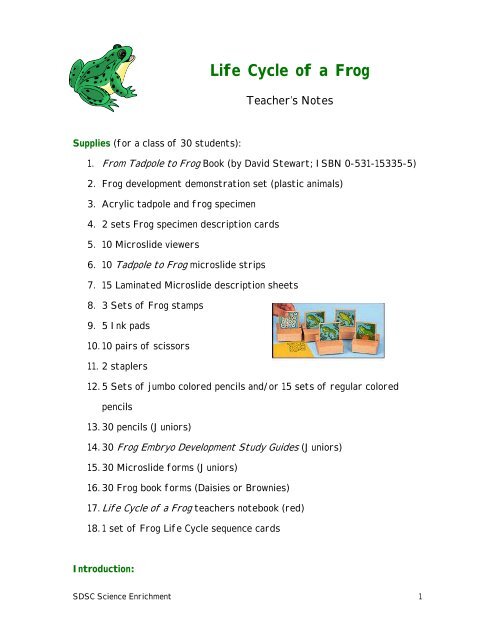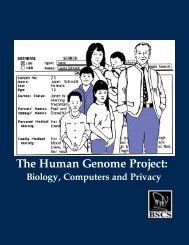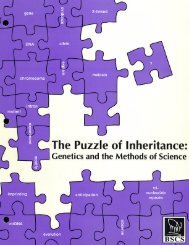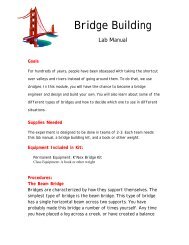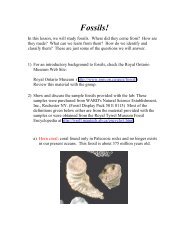Print the Life Cycle of a Frog Teacher's Notes. - SDSC Education
Print the Life Cycle of a Frog Teacher's Notes. - SDSC Education
Print the Life Cycle of a Frog Teacher's Notes. - SDSC Education
- No tags were found...
Create successful ePaper yourself
Turn your PDF publications into a flip-book with our unique Google optimized e-Paper software.
<strong>Life</strong> <strong>Cycle</strong> <strong>of</strong> a <strong>Frog</strong>Teacher’s <strong>Notes</strong>Supplies (for a class <strong>of</strong> 30 students):1. From Tadpole to <strong>Frog</strong> Book (by David Stewart; ISBN 0-531-15335-5)2. <strong>Frog</strong> development demonstration set (plastic animals)3. Acrylic tadpole and frog specimen4. 2 sets <strong>Frog</strong> specimen description cards5. 10 Microslide viewers6. 10 Tadpole to <strong>Frog</strong> microslide strips7. 15 Laminated Microslide description sheets8. 3 Sets <strong>of</strong> <strong>Frog</strong> stamps9. 5 Ink pads10. 10 pairs <strong>of</strong> scissors11. 2 staplers12. 5 Sets <strong>of</strong> jumbo colored pencils and/or 15 sets <strong>of</strong> regular coloredpencils13. 30 pencils (Juniors)14. 30 <strong>Frog</strong> Embryo Development Study Guides (Juniors)15. 30 Microslide forms (Juniors)16. 30 <strong>Frog</strong> book forms (Daisies or Brownies)17. <strong>Life</strong> <strong>Cycle</strong> <strong>of</strong> a <strong>Frog</strong> teachers notebook (red)18. 1 set <strong>of</strong> <strong>Frog</strong> <strong>Life</strong> <strong>Cycle</strong> sequence cardsIntroduction:<strong>SDSC</strong> Science Enrichment 1
This lab has 4 different parts. You can elect to divide <strong>the</strong> girls into groupsand have <strong>the</strong>m rotate or do each activity with <strong>the</strong> full group. I suggest that<strong>the</strong> book is read to everyone at <strong>the</strong> beginning so that everyone has <strong>the</strong>necessary background to complete all <strong>of</strong> <strong>the</strong> activities. Activities 2 and 3are best done with half <strong>of</strong> <strong>the</strong> group. Split <strong>the</strong> group in two and rotate. For<strong>the</strong> younger girls, activities 2 and 3 are just observations so 5 minutes ateach is fine. For <strong>the</strong> older girls, you will want to allow <strong>the</strong>m 10 - 15 minutesare each to complete <strong>the</strong> associated worksheet. Activity 4 is optional forJuniors.Activity 1: Book and Group DiscussionStart <strong>the</strong> lab with reading <strong>the</strong> frog development booktitled From Tadpole to <strong>Frog</strong>. For <strong>the</strong> younger girls orthose with language difficulties, use <strong>the</strong> manipulativesincluded to explain <strong>the</strong> stages <strong>of</strong> frog development.For Daisies and Brownies, this book should have enoughdetail. For Juniors I suggest using <strong>the</strong> <strong>Life</strong> Sequences cards after reading<strong>the</strong> book. The cards can also be used in conjunction with <strong>the</strong> BioQuest <strong>Frog</strong>Development Study Kit. (See activity #2).Activity 2: Examining <strong>the</strong> BioQuest <strong>Frog</strong> SpecimensPass around <strong>the</strong> specimen. In <strong>the</strong> instructors notebook (check <strong>the</strong> pouch)are two sets <strong>of</strong> 8 laminated cards that describe what is in each well. Discussthis with <strong>the</strong> younger girls and check for similar developmental stages on <strong>the</strong>life cycle cards.<strong>SDSC</strong> Science Enrichment 2
For <strong>the</strong> older girls, give each girl a <strong>Frog</strong> Embryo Development Study Guideand a pencil. Allow <strong>the</strong> girls to read <strong>the</strong> description cards and work in smallgroups to study all <strong>of</strong> <strong>the</strong> wells. The life cycle cards can be used inconjunction with <strong>the</strong> BioQuest <strong>Frog</strong> Development Study Kit.Part 3: Viewing MicroslidesEach girl should take some time to look at all <strong>of</strong> <strong>the</strong> stages <strong>of</strong> development.A laminated microslide description sheet is available for each viewer. Itexplains in detail what is in each image. This sheet will be especially usefulfor <strong>the</strong> Juniors. Take some time to talk about each stage and discuss what<strong>the</strong>y are seeing. For <strong>the</strong> older girls pass out <strong>the</strong> microslide worksheet. Thegirls should draw (using colored pencils) what <strong>the</strong>y see in each view on <strong>the</strong>microslide. This is very similar to <strong>the</strong> lab notebooks biologists keep whenstudying microscopic specimens.Part 4: DocumentingIn <strong>the</strong> final exercise each girl should make a frog development book. Passout <strong>the</strong> 2 pages <strong>of</strong> <strong>the</strong> book worksheets and scatter <strong>the</strong> stamps around <strong>the</strong>room. Each girl should put <strong>the</strong> appropriate stamp on each page. She can<strong>the</strong>n color in <strong>the</strong> pictures using <strong>the</strong> colored pencils. When finished, cutaround <strong>the</strong> boxes and staple to make a book. If time remains, read <strong>the</strong> bookas a group.<strong>SDSC</strong> Science Enrichment 3


